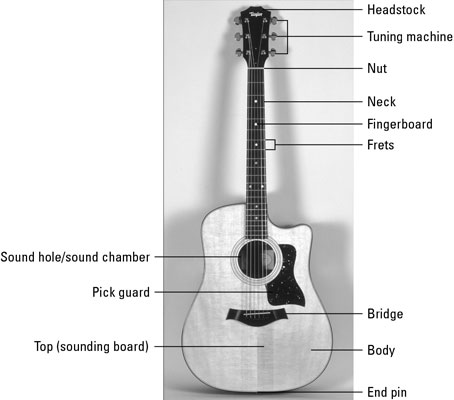All guitars share certain characteristics that make them behave like guitars and not violins or tubas. Understanding the anatomy of an acoustic guitar is important for understanding how to make music with it and how to take care of it.
Both acoustic and electric guitars follow the same basic approach to such principles as neck construction and string tension, and so they have very similar constructions, despite a sometimes radical difference in tone production.
Here is a quick rundown of the guitar's various parts and what they do:

Back: The part of the body that holds the sides in place; made of two or three pieces of wood.
Body: The box that provides an anchor for the neck and bridge and creates the playing surface for the right hand. On an acoustic, the body includes the amplifying sound chamber that produces the guitar’s tone.
Bridge: The wooden plate that anchors the strings to the body.
End pin: A metal post where the rear end of the strap connects. On acoustic-electrics (acoustic guitars with built-in pickups and electronics), the pin often doubles as the output jack where you plug in.
Fingerboard: A flat, plank-like piece of wood that sits atop the neck, where you place your left-hand fingers to produce notes and chords. The fingerboard is also known as the fretboard because the frets are embedded in it.
Frets: Thin metal wires or bars running perpendicular to the strings that shorten the effective vibrating length of a string, enabling it to produce different pitches.
Headstock: The section that holds the tuning machines (hardware assembly) and provides a place for the manufacturer to display its logo.
Neck: The long, club-like wooden piece that connects the headstock to the body.
Nut: A grooved sliver of stiff nylon or other synthetic substance that stops the strings from vibrating beyond the neck. The strings pass through the grooves on their way to the tuners in the headstock. The nut is one of the two points at which the vibrating area of the string ends. (The other is the bridge.)
Sides: Separate curved wooden pieces on the body that join the top to the back.
Strap pin: Metal post where the front, or top, end of the strap connects. (Not all acoustics have a strap pin. If the guitar is missing one, tie the top of the strap around the headstock.)
Strings: The six metal (for steel-string acoustic guitars) or nylon (for classical guitars) wires that, drawn taut, produce the notes of the guitar. Although not strictly part of the actual guitar (you attach and remove them at will on top of the guitar), strings are an integral part of the whole system, and a guitar’s entire design and structure revolves around making the strings ring out with a joyful noise.
Top: The face of the guitar. On an acoustic, this piece is also the sounding board, which produces almost all the guitar’s acoustic qualities.
Tuning machines: Geared mechanisms that raise and lower the tension of the strings, drawing them to different pitches. The string wraps tightly around a post that sticks out through the top, or face, of the headstock. The post passes through to the back of the headstock, where gears connect it to a tuning key (also known as tuners, tuning pegs, and tuning gears).

